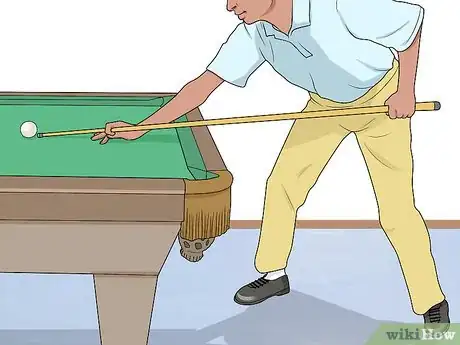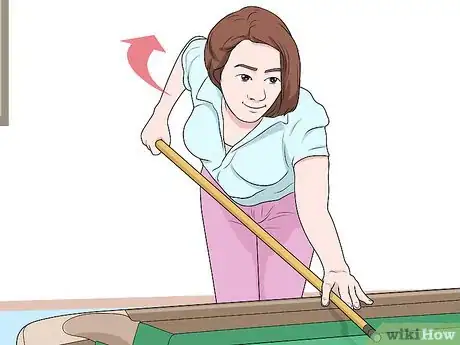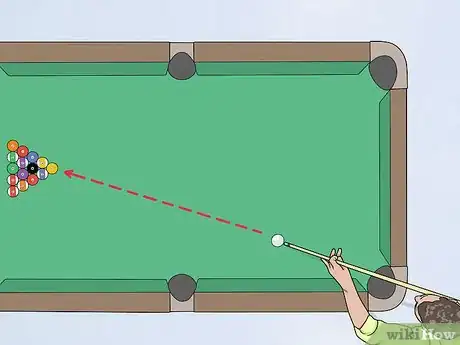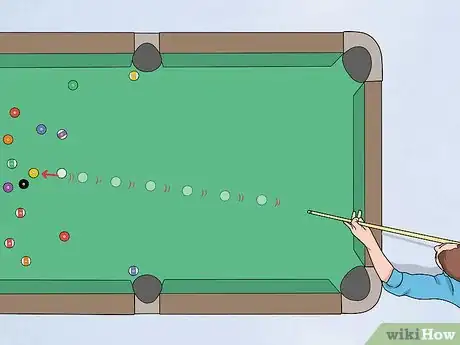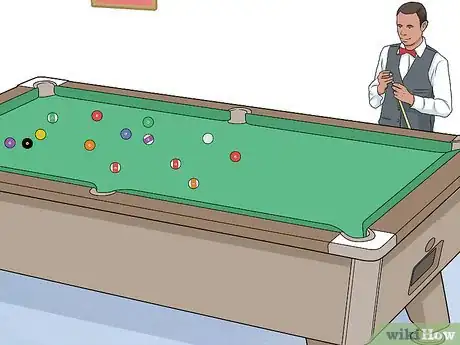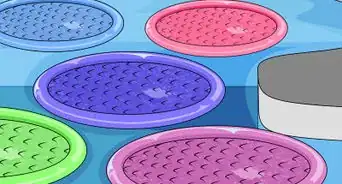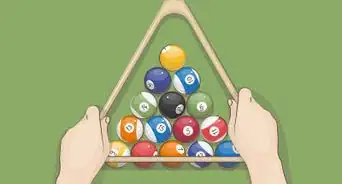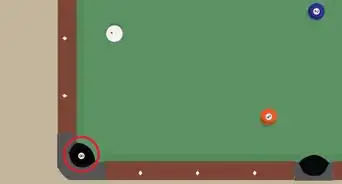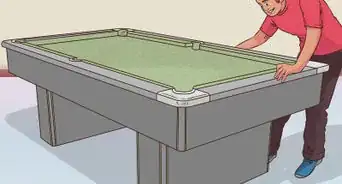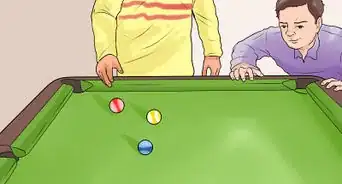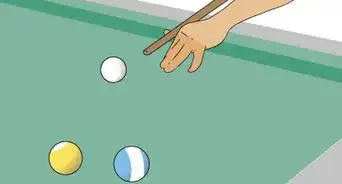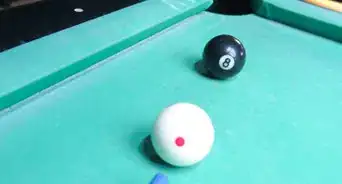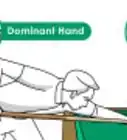This article was co-authored by wikiHow Staff. Our trained team of editors and researchers validate articles for accuracy and comprehensiveness. wikiHow's Content Management Team carefully monitors the work from our editorial staff to ensure that each article is backed by trusted research and meets our high quality standards.
wikiHow marks an article as reader-approved once it receives enough positive feedback. In this case, 94% of readers who voted found the article helpful, earning it our reader-approved status.
This article has been viewed 220,572 times.
Learn more...
Being asked to break the rack is a privilege. Since it often sets the tone for the game, you may be interested in how to do it with grace and skill. Although a forceful break is exciting to watch, you don’t need to set off fireworks with your break shot. Focus on your posture, relax your cue hand, and use your hips to move your body forward into a successful break shot.
Steps
Getting into Position
-
1Rack the balls. Gather the balls and put them in the rack. Align the base of the rack so it is parallel to the back of the pool table. Put the eight ball in the center of the rack. Put a solid ball in one corner, and a striped ball in the other corner. Then, press the balls together tightly, so that all of the balls are in contact with one another.[1]
-
2Place the cue ball on or behind the head string. You can put the cue ball anywhere on or behind the head string, which is the quarter of the pool table furthest away from the rack.[2] It is best not to put the ball right in the middle of the head string directly opposite the head ball in the rack, since the pool table will be more worn down in this area and you may not get as good a shot. Instead, place the ball a little bit off to one side or the other, which will also make it easier to aim.[3]Advertisement
-
3Stand behind the cue ball with your feet spread apart. You should be leaning forward from the waist, and your knees should be slightly bent. You should be holding the pool cue with both hands, and the cue should be directed towards the cue ball. Find a hip width that feels right for you.[4]
- A wider stance will give you more stability.
- A narrower stance will allow for more momentum as you move your hips forward through the shot.
- You’ll be slightly more upright than for a regular shot.
-
4Place your hand on the table in a closed bridge. Put your hand on the table, and then lay the pool cue across the middle of your thumb and index finger. Curl your index finger around the cue. Then, touch your index finger with your thumb so that you have a circle around the shaft. Spread your fingers for greater stability. Your bridge hand should be loose and relaxed to ensure accuracy.[5]
- Since your torso will move up when you hit the ball, a closed bridge will prevent your tip from rising up and help ensure greater accuracy.[6]
-
5Set the distance between your bridge hand and the ball. Some people prefer a slightly longer bridge distance on their break shot. For instance, some people set up their bridge hand eight or ten inches from the ball, which allows for greater force. However, if your bridge distance is too great, you may compromise your accuracy. You’ll have to experiment until you find a distance that works well for you, such as six or eight inches.[7]
- Beginners often rest their stick on the back rail. On a regulation table, that puts you too far away.
-
6Move your back hand into position behind your shoulder. With your back hand, hold the back of the pool cue with a firm grip. Close your fingers around the pool cue. Bring it into position, which is behind your shoulder and just above your hip.[8]
- Some people prefer a longer backswing, which allows for greater force in the break shot.
- Some people prefer to choke up slightly on the backswing, which can ensure greater accuracy.
Aiming
-
1Aim straight at the head ball. You want to hit the center of the head ball, which is the ball at the top of the rack. By hitting the center of the head ball, you will efficiently transfer force towards the rest of the rack and properly distribute the balls.[9]
- Some players aim for the second row of balls in order to bounce the cue ball off a rail and back into the rack for more action.
-
2Line up your cue with the cue ball. You’ll want to hit the cue ball ½’’ (13 millimetres) below the center, which is the size of the tip of your pool cue. By hitting it just below the center, you can make the cue ball stop in the middle of the table after the break. With the cue ball in the middle of the table, you’ll be in a much better position for your next shot![10]
-
3Focus your attention on the ball. Start by glancing back and forth between the cue ball and the head ball. Once you feel comfortable with the shot, direct your focus to either the head ball or the cue ball. Keep your eyes on the ball before shooting![11]
-
4Study the object paths in a break. You can make subtle adjustments to your aim based on the object paths involved in your break. If you are playing eight ball, you might be able to sink the two balls behind the head ball into the side pockets. However, if you are playing nine ball, you could possibly get the wing balls in the back pockets. Make adjustments to your aim until you are able to sink some of these balls more reliably with your break.[12]
Shooting
-
1Pull your cue back slowly with your back hand. Bring your back hand behind your shoulder and just above your hips. If you want more of a back swing, you can bring it back a little further. Steady your bridge hand, relax, and get ready to shoot![13]
- You want a smooth, controlled backswing with full follow-through. A steady, square impact carries more force than a lightning-fast shank.
-
2Make direct contact with the head ball. To break the rack effectively, hit the head ball directly on target. You’ll also need to apply sufficient force to distribute the balls around the table. However, it is best to relax and focus on a square hit, as opposed to trying to apply excessive force. The main thing is to hit the head ball squarely![14]
- The force in the break shot comes from the legs and hips. Move your hips forward to achieve greater force.
-
3Shoot the cue ball. Hit the cue ball with the cue stick. Move your body forward from the hips to apply more power in your break shot. Let your torso move up at the end of the stroke. Your cue stick should be pointing towards the back of the table when you finish.[15]
-
4Fine tune your break shot by watching where the balls land. Take a moment after each shot to note the position of the cue ball and the formation on the table. If the cue ball tends to drive forward after impact, hit it lower for more backspin. If it likes to veer off toward the sides, hit it slower for greater accuracy and power.[16]
- If you are close to sinking the two balls behind the cue ball, think about how you could fine tune your shot to sink them in the corner pockets.
Community Q&A
-
QuestionInadvertent potting the black ball
 Community AnswerIt will depend on the league. In some leagues, if you sink the eight ball (black) on the break, you win! However, if you sink it and also scratch the cue ball, the opponent wins. In other leagues and tournaments, the opponent has a few options, such as racking and breaking him or herself.
Community AnswerIt will depend on the league. In some leagues, if you sink the eight ball (black) on the break, you win! However, if you sink it and also scratch the cue ball, the opponent wins. In other leagues and tournaments, the opponent has a few options, such as racking and breaking him or herself. -
QuestionAre there left-handed pool cues?
 Community AnswerNo; the same cue can be used either right- or left-handed.
Community AnswerNo; the same cue can be used either right- or left-handed. -
QuestionWhen I put a ball in and scratch, do I spot the ball that I just scratched on?
 Community AnswerIllegally sunk balls due to fouls remain sunken, unless it was the 8-ball, in which case that player loses the game.
Community AnswerIllegally sunk balls due to fouls remain sunken, unless it was the 8-ball, in which case that player loses the game.
References
- ↑ https://upatour.com/8-ball-rules/
- ↑ https://upatour.com/8-ball-rules/
- ↑ https://www.thoughtco.com/power-breaking-in-photos-368910
- ↑ https://www.pooldawg.com/article/pooldawg-library/tips-for-smashing-the-rack
- ↑ http://www.billiardworld.com/bridges.htm
- ↑ https://www.pooldawg.com/article/pooldawg-library/tips-for-smashing-the-rack
- ↑ https://www.pooldawg.com/article/pooldawg-library/tips-for-smashing-the-rack
- ↑ http://www.artofmanliness.com/2017/02/24/break-rack-pool/
- ↑ https://www.thoughtco.com/9-ball-rack-and-break-tips-and-strategy-368458
- ↑ https://www.pooldawg.com/article/pooldawg-library/tips-for-smashing-the-rack
- ↑ https://www.pooldawg.com/article/pooldawg-library/tips-for-smashing-the-rack
- ↑ https://www.pooldawg.com/article/pooldawg-library/tips-for-smashing-the-rack
- ↑ http://www.artofmanliness.com/2017/02/24/break-rack-pool/
- ↑ https://www.pooldawg.com/article/pooldawg-library/tips-for-smashing-the-rack
- ↑ https://www.thoughtco.com/power-breaking-in-photos-368910
- ↑ https://www.thoughtco.com/power-breaking-in-photos-368910


